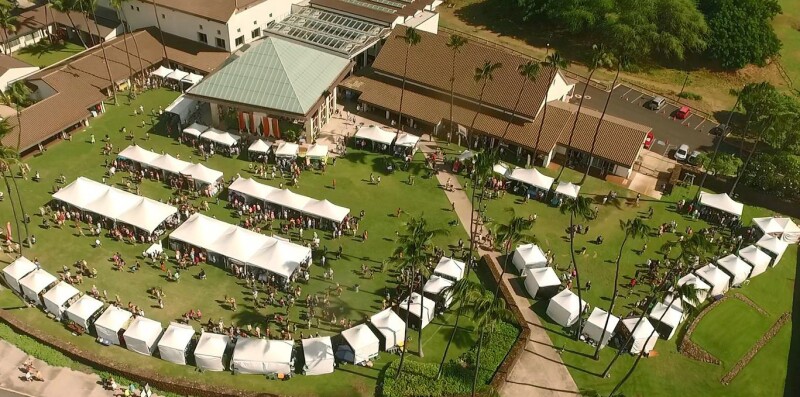Cloud shadows and rays of sun dapple Maui’s Mauna Kahalawai—a 1.7-million-year-old extinct volcano. Families stroll around a palm-fringed lake, feeding ducks and taking selfies. Some dip into The Mill House restaurant, where Chef Taylor Ponte turns ingredients from the surrounding area into dishes like taro leaf risotto.
It’s all part of a typical day at Maui Tropical Plantation (MTP), a multi-purpose project born with rescue of 1,800 acres that had been depleted by 150 years of growing sugar cane. Today, it’s enhancing the soil and cultivating show crops, as well as renting fields and orchards to farmers. It’s also fast become an anchor attraction for Central Maui. The plantation has a free park with a café, fine dining, farm tours, and a boutique selling locally made art and products. As if that wasn’t enough, the plantation hosts a zipline company and partners with companies like Pacific Biodiesel, the nation’s longest-operating producer of biofuel, which grows sunflowers for cooking and automotive use there. It also provides space for Love the Sea, a nonprofit that reclaims plastics out of the ocean.
And MTP is hardly alone; many business on Maui are forging ahead with efforts that help protect the planet. Here’s how you can support them.
Companies That Care
In terms of ecology, one of the island’s brightest lights remains the Maui Ocean Center (MOC), the Aquarium of Hawaii. The park features aquatic wonders—from a lagoon sheltering the world’s largest hard-shelled sea turtles to an immersive humpback film screened in a first-of-its-kind 3D sphere—while it educates visitors on conservation and how to be responsible stewards of the sea.
“The geographic isolation of islands makes these ecosystems very fragile to introduced species, depletion of natural resources and loss of habitats,” explains MOC’s Director of Education, Lillian Solano. “Hawaii’s isolation has contributed to a high number of endemic species: organisms only found here and nowhere else in the world.”

Photo Courtesy Mermaid Dreams
CASSIE PALI
One threat to these species is sunscreen, says Lila Jones, who teaches conservation via her Mermaid Dream Retreats company (which features mermaid lessons, among other offerings). In 2021, Hawaii’s ban on products containing reef-harming oxybenzone and octinoxate will go into effect. In the meantime, Jones suggests sun-protective UPF clothing like rash guards and leggings as an alternative to sunscreen. But for visitors craving Vitamin D and the kiss of tropical sun on their skin, she recommends Raw Love Sunscreen, created by Maui-based Jenna Davis, a dive master and marine biologist. It’s Hawaii’s first—and only—plastic-free, FDA-compliant sunscreen company. Other great eco-friendly buys include HI Spice’s hot sauce, crafted from locally grown chili peppers, and Maui Nui Venison, made from humanely harvested invasive deer. Beer aficionados should try Dogfish Head’s golden ale, brewed with local ‘ulu (breadfruit)—a “canoe crop” brought to the archipelago by Polynesian settlers. Or take things up a notch with Ocean Organic Vodka’s shame-free spirits, distilled upcountry on Haleakalā’s slope from sugar cane and deep-sea mineral water.
Want to go green in terms of fashion on the Valley Isle? Shop at the female-founded Monarch Collective in Makawao or Tula, a Molokaʻi-based jewelry company that designs with shells and sea glass. Or hit the Maui Swap Meet on Saturday mornings for 808 Clothing T-shirts screened with locally produced art, among other great finds.
Whatever souvenir you seek, look for the “Made in Maui” seal, that shows residents added at least 51% of a product’s value.

Photo Courtesy Hawaiian Airlines Made in Maui County Festival
Festivals Supporting Maui
For those who like to be spoiled by choice, the island has a wide array of events where travelers can support local communities. Head to autumn’s Hawaiian Airlines Made in Maui County Festival to peruse 140 vendors, ranging from Dope BBQ to Da Beehive Hawaii and Sailbags Maui, which upcycles kitesurfing sails into chic totes. Come spring, tuck into the East Maui Taro Festival in Hāna or the Maui County Agricultural Festival, which includes a farmers’ market, zero-waste workshops, and a master-gardener help desk. Maui may be in tune with the seasons, but it doesn’t wait for them to celebrate island talent. Fridays bring Town Parties—a great opportunity to shop local and meet Hawaiians. And remember, even the simplest gesture can be powerful, according to Solano, like staying on the trail during a hike and leaving a beach in better shape than you found it.
“Be respectful of the ‘āina (land),” she reminds visitors. “We want to take care of this fragile island ecosystem, so it continues to thrive for generations to come.”
Learn more about Maui’s conservation and eco-consciousness at gohawaii.com/islands/maui








